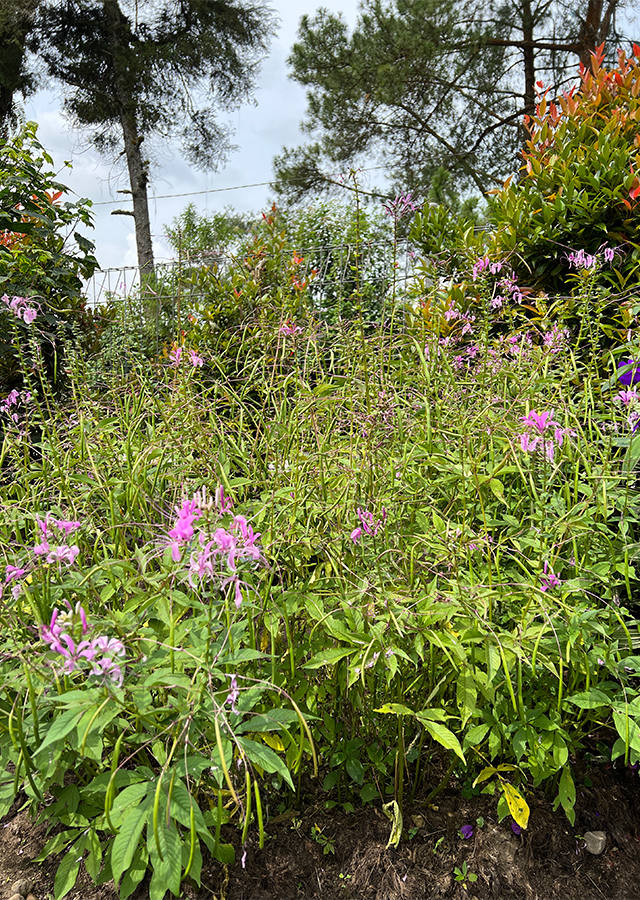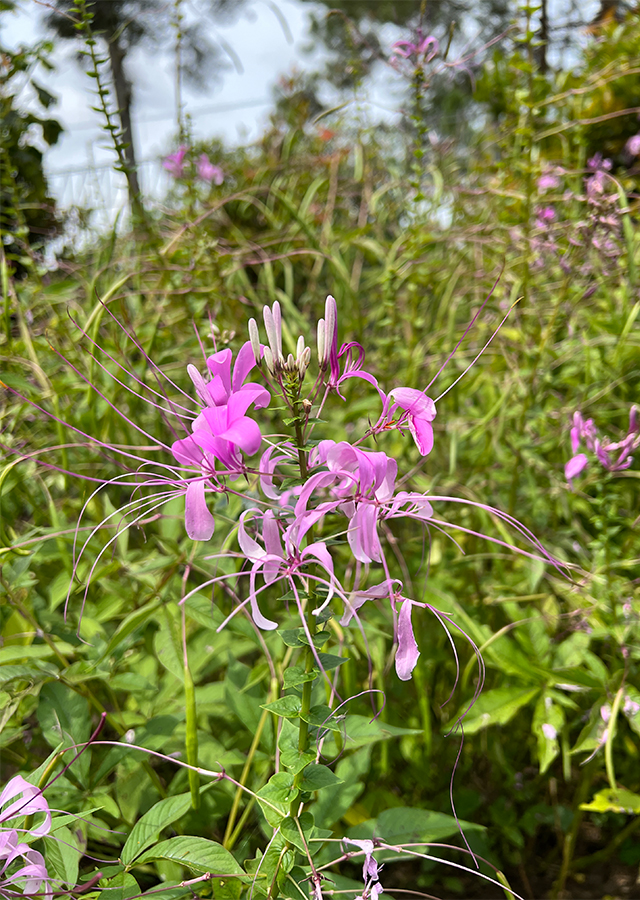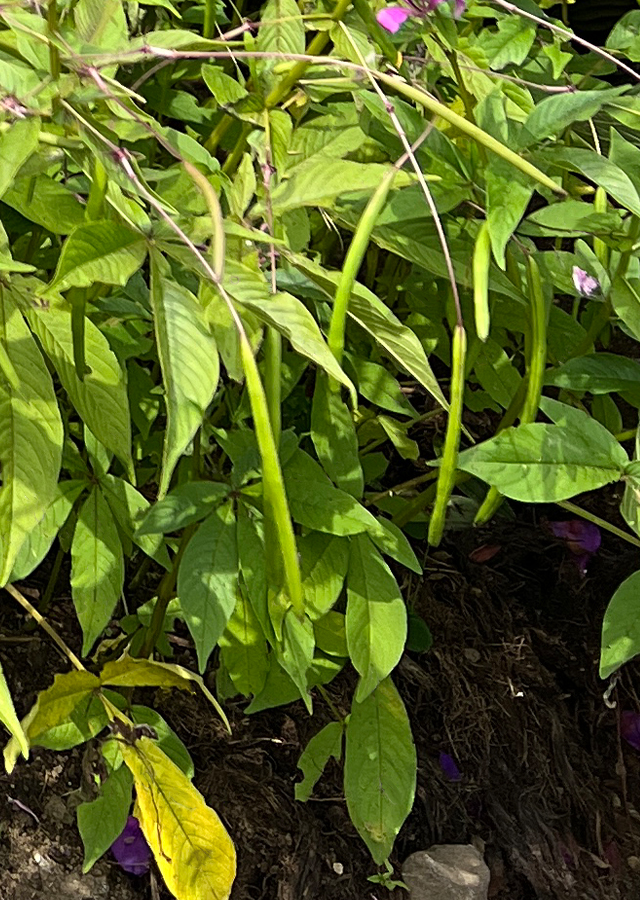Spider Flower
Cleome houtteana Schltdl.
Cleomaceae
Location in our garden
Principal



Synonym
Cleome hassleriana Chodat
Tarenaya hassleriana (Chodat) Iltis
Tarenaya hassleriana var. parviflora Verloove & Lambinon
Habitus
Herbaceous. An evergreen annual herbaceous plant that grows about 0.9-1.5 m tall.
Part Used
Leaves
Flowers
The Whole Plant
Growing Requirements
Full Sunshine
Need Shade
Drought Resistant
Habitat
Riverbanks
Roadside
Terrestrial
Overview
Cleome houtteana is native to South America (Brazil, Argentina, Paraguay, and Uruguay). This plant is dubbed "Spider flower" because of the fanciful resemblance of the long stamens to spider legs. It is used as a medicine and has environmental uses. It makes good additions to mixed flower borders adding architectural interest and a sub-tropical feel.
Vernacular Names
No found data on this. Need further research.
Agroecology
This plant is cultivated, rarely escaping to roadsides, railroads, disturbed areas, streambanks. Prefers full sun or semi shade in moist soil. The substrate should be sandy soil or fertile sandy loam, good soil drainage. The plant tolerates temperatures at least 1 °C and is drought tolerant. Although it tolerates dry conditions, watering will promote better growth and flowering but overwatering and overfertilizing causes leggy growth.
Morphology
- Stems - erect, to 1.5 m, usually simple, densely glandular-hairy and with some appressed cobwebby pubescence above, with a prickly stipule at the base of each leaf petiole.
- Leaves - alternate, rough, sticky, petiolate, palmately 5-7 compound. Stipules relatively stout golden brown spines 1-4 mm long. Petioles 6-15 cm long, adaxially grooved, hairy and glandular. Leaflets 3-10 cm long, 4 cm broad, oblanceolate to elliptic, acute to acuminate, tapered at base, entire or shallowly toothed, the upper surface glandular-pubescent, the lower surface sparsely pubescent and with prickles along the midrib. Petiolules to 4 mm long.
- Flowers - inflorescence dense terminal raceme to 35 cm long. Pedicels 4-6 cm long in flower, densely glandular, elongating in fruit. Bracts 1-4 cm long, 0.5-2.0 cm broad, simple, short-stalked to nearly sessile, ovate, cordate, tapered to a sharply pointed tip, densely glandular, with spines at base. Sepals basally fused, 6-7 mm long, narrowly lanceolate, reflexed but with tips ascending, densely glandular and sometimes also sparsely hairy. Petals 4, 18-28 mm long, 6-8 mm wide, with a basal claw 6-12 mm long, pink to purple, rarely white. Glandular disc fleshy, conical, 1-3 mm long. Stamens with the filaments 3-4 cm long, the anthers 7-9 mm long, linear. Stamens 6, erect to spreading. Filaments to 1 cm long, glabrous, rose-pink. Anthers 1 cm long, yellow-orange. Ovary green, 4 mm long, glabrous.
- Fruits - capsules 2-7 cm long, 3-4 mm wide, linear, 2-valved, with persistent stigma, usually slightly constricted between seeds, glabrous.
- Seeds - numerous, 1.6-2.0 mm in diameter, the surface appearing wrinkled or warty, round dark brown with lighter-colored warts and faint concentric lines.
Cultivation
- Generatively propagated by seed.
- Sow into 9 cm pots or deep modular trays of pre-watered seed compost. These plants do not like their roots disturbed. Keep at 15-20 °C and keep moist. Germination should occur within 14 to 28 days. Grow on in cooler conditions, acclimatising plants before planting out after the last frosts. Space them 45 cm apart Direct sow outdoors in a warm, sunny site with well drained soils. Thin seedlings to 5 cm apart and then again until a final spacing as above.
Chemical Constituents
3-(2''-(6'''-caffeoyl-β-glucopyranosyl)-6''-(E-p-coumaroyl)-β-glucopyranoside)-5-β glucopyranoside, cyaniding 3-(2''-(6'''-E-sinapoyl-β-glucopyranosyl)-6''-(E-p-coumaroyl)-β-glucopyranoside)-5-β-glucopyranoside,cyanidin 3-(2''-(6'''-feroyl-β-glucopyranosyl)-6''- (E-p-coumaroyl)-β-glucopyranoside)-5-β-glucopyranoside, pelargonidin 3-(2''-(6'''-E-sinapoyl-β glucopyranosyl)-6''-(E-p-coumaroyl)-β-glucopyranoside)-5-β-glucopyranoside, pelargonidin 3-(2''-(6'''-E-p-coumaroyl-β-glucopyranosyl)-6''-(E-p-coumaroyl)-β-glucopyranoside)-5-β-glucopyranoside.
Traditional Medicinal Uses
- Studies have shown that this species can be a potential source of active compounds that will allow the development of new therapeutic alternatives for the treatment of diseases in which an inflammatory and/or pain process and antinociceptive occurs.
- It is used for bruises and rheumatism.
Part Used
Reference Sources
- Candide. (No date). Spider Flower-Cleome houtteana. https://candide.com/ZA/plants/fc9589d3ef15d6a222fea3958b409cac. 02-07-2022.
- National Park of Singapore. (2022). Flora Fauna Web: Cleome hassleriana Chodat. https://www.nparks.gov.sg/florafaunaweb/flora/3/3/3313. 02-07-2022.
- Kew Royal Botanic Gardens. (No date). Plants of the World Online: Cleome houtteana Schltdl. https://powo.science.kew.org/taxon/urn:lsid:ipni.org:names:147105-1#descriptions. 02-07-2022.
- Mahr, Susan (No date). Spider flower, Cleome hassleriana. https://hort.extension.wisc.edu/articles/spider-flower-cleome-hassleriana/. 02-07-2022.
- Missouri Plants. (No date). Cleome hassleriana Chodat, Spider Flower. http://www.missouriplants.com/Cleome_hassleriana_page.html. 02-07-2022.
- María del Carmen Juárez-Vázquez and María Adelina Jiménez-Arellanes. (2019). Phytochemical investigation, anti-inflammatory and antinociceptive activities from some species of Cleomaceae family: A systematic review. Advancement in Medicinal Plant Research, Vol. 7(4), pp. 107-128. DOI: 10.30918/AMPR.74.19.039. ISSN: 2354-2152.


